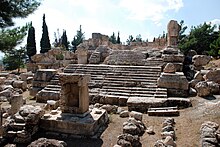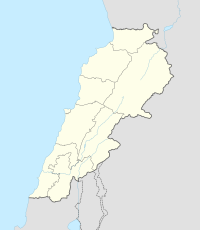Qasr el Banat, Lebanon
Castra El Banaat | |
 | |
| Alternative name | Qasr el Banât, Qasr al Banat, Kasr el-Banat, Qasr/Castra El-Banaat |
|---|---|
| Region | Baalbek |
| Coordinates | 34°05′15″N 36°07′04″E / 34.0875°N 36.117778°E |
| Site notes | |
| Condition | Ruins |
| Public access | Yes |
Qasr el Banat (
History
It is believed the site was called the "Castle of Virgins" and was the residence of
By the middle of the 2nd century, the Romans had built many small temples and other sanctuaries in the vicinity of the temple district of Heliopolis, today's
George F. Taylor classified Qasr el Banat among a group of ancient Roman
There are two circular structures located around 100 metres (330 ft) southeast of the temple that are thought to have been examples of the high places referred to in the Bible.
Characteristics
The Prostylos Temple of
It was composed of parts and supplemented in a further restoration phase after 1993. The columns of the vestibule were crowned by Corinthian capitals. Individual parts of the pediment triangle were assembled in the original form and placed as a whole at ground level next to the temple. In the upper cornice, a carved relief bust is preserved at the top of the gable. It shows the bearded head of a man who probably represents the founder of the building.
See also
- Temples of the Beqaa Valley
- Roman Phoenicia
References
- ^ a b George Taylor (1967). The Roman temples of Lebanon: a pictorial guide. Dar el-Machreq Publishers. Retrieved 1 November 2012.
- ISBN 978-1-57506-014-9. Retrieved 1 November 2012.
- ISBN 9783886181056.. B. Dau.
- Dau, Butros (1984). History of the Maronites: Relig[i]ous, Cultural, and Political
External links
- Photo of the temple at Qasr el Banat on picasaweb
- Photo of the temple at Qasr el Banat on panoramio.com
- Photo of the temple at Qasr el Banat on panoramio.com
- Photo of the view from Qasr el Banat on panoramio.com
- Visiting Deir el Ahmar in Bekaa Valley, Lebanese Ministry of Tourism brochure
- Qasr El-Banat on middleeast.com
- Qasr el Banat on mapatlas.org
- Qasr el Banat on geographic.org


